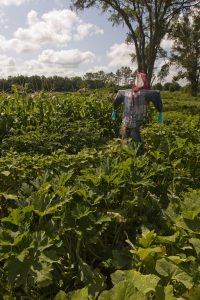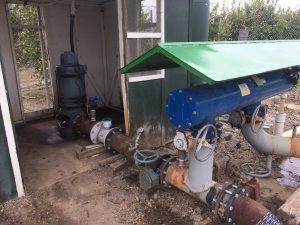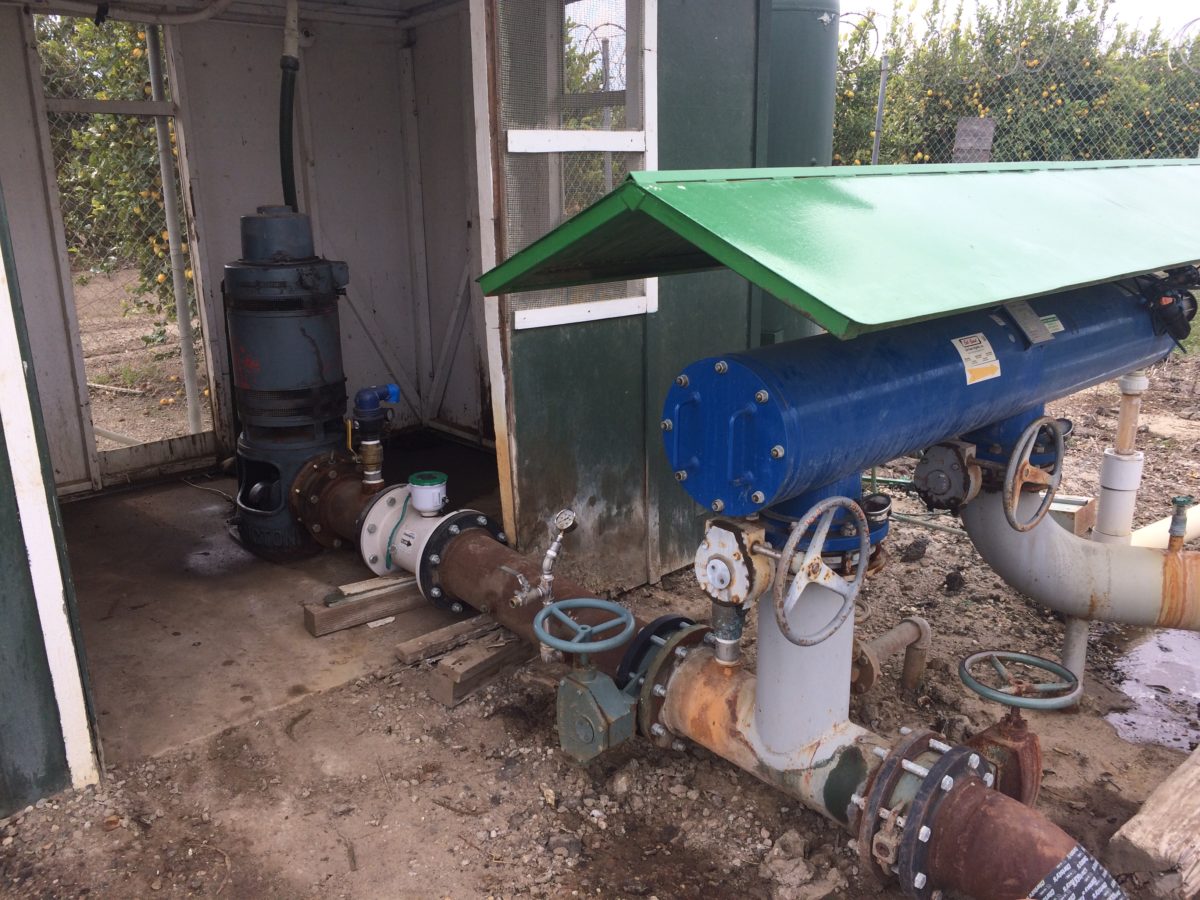
A scarecrow in a 4-H youth vegetable garden in Gilchrist County, Florida. (UF/IFAS Photo: Tyler Jones)
By Travis K. Chapin and Michelle D. Danyluk
Good agricultural practices have been followed by fresh fruit and vegetable producers for decades on a voluntary and market-driven basis to reduce risks from produce safety hazards. Such hazards include microbial pathogens, chemicals and physical hazards like broken glass or plastic. More recently, growers have been fulfilling the Food Safety Modernization Act’s (FSMA) Produce Safety Rule (PSR) requirement to attend standardized food safety training. One option is the Produce Safety Alliance (PSA) grower training course, which outlines minimum requirements of the PSR.
Extension agents and specialists from the University of Florida Institute of Food and Agricultural Sciences (UF/IFAS) have been involved with developing, piloting and rolling out the National Association of State Departments of Agriculture’s on-farm readiness review (OFRR) program. It provides one-on-one voluntary technical assistance to farms to evaluate their level of readiness to meet the new regulatory food safety requirements. As a result of the development of the OFRR program, dozens of farms across the United States have been evaluated by Extension specialists/agents and state and federal regulators for their readiness to meet the requirements of the PSR. The PSR requirements are almost exclusively devoted to preventing microbial contamination. They are specifically related to worker training, health and hygiene; biological soil amendments of animal origin; wildlife and domesticated animals; agricultural water quality; sanitation; and recordkeeping.
The PSR will be implemented on tens of thousands of diverse farms across the United States and around the world. Due to the diversity of farms that will need to implement its requirements, the PSR provides significant flexibility in how farmers may approach minimizing food safety risks in their operations. The Food and Drug Administration (FDA) intends to release official regulatory guidance that will outline the agency’s current thinking on best practices to reduce risk and meet PSR requirements.
FDA and the state departments of agriculture tasked with implementing the PSR continue to reiterate that their initial approach will be educational. State and federal regulators will work with growers to understand and meet the regulatory requirements as they begin scheduling and conducting PSR inspections starting in the spring of 2019. A regulatory PSR inspection will likely take a full day or more. In addition to implementing practices to meet the minimum regulatory requirements outlined in the PSA grower training and OFRRs, taking a few additional considerations that go beyond the minimum requirements in some cases, and paying particular attention to other key requirements, may help prepare growers for a more streamlined and efficient inspection. These include:
VISITOR POLICY
A written visitor policy is not required in the PSR but is a convenient way to make visitors, including inspectors, aware of the farm’s food safety policies. These policies can include prohibiting visitors who have any signs or symptoms of foodborne illness and preventing visitors from eating, chewing gum or using tobacco in produce or packing areas. Visitors need access to restrooms and handwashing facilities and should be made aware of the location of those facilities. Your visitor policy should not prohibit regulatory personnel from taking pictures or collecting samples.
FARM DIAGRAM
A farm diagram is not one of the required records under the PSR. However, during the initial inspection, an inspector will likely need to create or verify a map of the farm layout including structures, water sources and water distribution systems in order to assess the potential for different risks of contamination. The diagram could also include housing, septic systems, animal grazing or housing, chemical storage, locations of manure storage or composting, trash collection, adjacent land use and slope of land, including runoff potential. An evaluation of the farm layout may also consider operational flow, including traffic patterns for waste/cull removal and employee or equipment flow between different operations (for example, between preharvest and postharvest operations).
CORPORATE STRUCTURE
While specific guidance is pending and enforcement discretion related to FSMA is in place, an inspector will need to know some details about the corporate structure of the farm in order to define the scope of the inspection. For example, many farms may appear to be a single entity, but family members, contractors and cooperatives may separately own or manage certain operations and therefore may require separate inspections — if all parties cannot be present or covered at one time. If you are claiming a “qualified exemption,” ensure that you have the required exemption records and supporting financial documents available for review.
PERSONNEL RESPONSIBILITY
Farms with multiple employees will want to identify the person or persons responsible for recognizing, detecting and correcting food safety issues, and for developing any food safety plans and procedures. It will also be important to identify personnel responsible for monitoring general cleaning and sanitation of tools, equipment and handwashing facilities.
WORKER TRAINING, HEALTH AND HYGIENE
All employees should be familiar with procedures to report illnesses and injuries. Records of worker training (for food safety) will be reviewed and should include the topics covered. Training materials may be reviewed more carefully if employees don’t seem to be following farm policies. Employee practices will be observed when workers are harvesting or packing, entering and exiting the field or packinghouse, and using restroom/handwashing facilities.
Supervisors and other employees tasked with food-safety responsibilities should have received additional training and should be able to describe the farm’s food-safety policies or practices. Evaluate the potential for crop contamination from splashes or leaks due to placement, servicing or other movement of portable toilet facilities.
BIOLOGICAL SOIL AMENDMENTS OF ANIMAL ORIGIN
Farms using manure and compost should determine whether the soil amendments are considered treated or untreated under the PSR and evaluate the application method of those soil amendments for the potential to contact the harvestable portion of the crop at any point during or after application. Although not required under the PSR, it may be helpful to document the date and method of soil amendment application.
WILDLIFE AND DOMESTICATED ANIMALS
Ensure employees are trained and aware of policies related to harvest and animal intrusion. Contamination should be identified and removed. “No harvest buffer zones” may be used as well.

Consider the location and types of backflow prevention devices and evaluate your well for backflow potential from unprotected hoses, faucets or other connections.
AGRICULTURAL WATER
Although FDA has proposed to extend the compliance dates for specific agricultural water requirements, evaluating agricultural water will still take up a large part of the inspection.
If using ground water, consider the construction and condition of your wells, such as being properly capped, elevated and sealed. Also consider the potential for backflow into the well and cross connections. Pay special attention to hoses or faucets connected to the well with no backflow prevention in place. If you’re not familiar with your well, have your service technician walk you through the components of it the next time you have it serviced, taking special note of the location and type of backflow prevention devices. You want to feel confident in describing your well and how it works.
If using surface water, examine the surrounding areas and/or upstream for potential sources of runoff contamination. Pay attention to the source of water used for crop sprays and premixed liquid fertilizers.
CLEANING, SANITATION AND POSTHARVEST PRACTICES
Evaluate your ability to document “clean breaks” or the potential for cross-contamination between different lots of produce. Although establishing a traceability program is not required under the PSR, evaluate your ability to track your inputs and your buyers in case of a future recall.
When evaluating your equipment, pay special attention to the potential for dripping water or condensate onto produce or onto food contact surfaces. If using harvest knives, make sure they are not left on the ground during breaks. Keeping a monitoring record of the sanitizer concentration in a tool dip could be used to satisfy the requirement for a cleaning and sanitizing record for harvest knives.
Additional Information
- Upcoming Produce Safety Alliance (PSA) grower trainings: http://sc.ifas.ufl.edu
- Florida on-farm readiness review (OFRR) or PSA grower training: www.freshfromflorida.com/FSMA
- Alabama OFRR or PSA grower training:
http://agi.alabama.gov/divisions/food-safety/fsma - Georgia OFRR or PSA grower training:
georgiafarmsafety.com - Details on the Produce Safety Rule:
http://www.fda.gov/fsma
Travis K. Chapin is a state specialized Extension agent and Michelle D. Danyluk is an associate professor at the UF/IFAS Citrus Research and Education Center in Lake Alfred.
Share this Post










